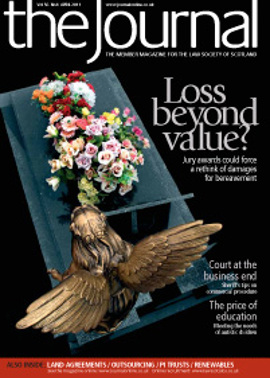Easing the burdens?
The Property Standardisation Group first produced styles of disposition after the abolition of the feudal system, when the profession was struggling with the new rules on the creation of real burdens and servitudes under the Title Conditions (Scotland) Act 2003. Although the Act made it possible to create new real burdens and servitudes in any deed, it is still most common for them to be created in a disposition or a deed of conditions.
The PSG produced two dispositions creating new real burdens and servitudes, the first creating real burdens on the property being sold and the other creating reciprocal real burdens and servitudes on the property being sold and the retained property.
In both dispositions we set out the new real burdens and servitudes in schedules. This has proved very popular with the Keeper as it makes it much easier for her staff to identify the new title conditions and dual register them.
We have recently revised the dispositions, making it easier for the user to select the relevant text for the various options, depending on whether the disposition is for first registration, already registered land, sale of whole, sale of part etc.
The dispositions contain wording dealing with:
- division of a benefited property;
- importing deeds of conditions created prior to the appointed day;
- community interests in land.
If title conditions are being imposed on two or more properties, the Keeper recommends that a deed of conditions is used, rather than creating the title conditions in the split-off dispositions, as this avoids the need to carry out multiple registrations against all the properties affected.
John King, Registration Director at RoS comments: “The updated dispositions are a welcome addition to the suite of standard deeds suggested by the PSG. We do recommend the use of a deed of conditions or deed of real burdens wherever possible, but where this is not appropriate the PSG dispositions are very helpful, ensuring that the drafter carefully identifies the burdened and benefited properties (any error at this stage can invalidate the real burdens), and reducing the scope for inadvertent mistakes by using the schedules. The styles make it easier for us to extract and set out information for inclusion in the burdens section of the burdened and benefited property title sheets and in the property section of the benefited proprietor’s title sheet.”
The revised dispositions can be found in the Title Conditions section on the PSG website www.psglegal.co.uk, where you will also find a deed of real burdens, deed of servitude and deed of conditions. We welcome your comments and feedback on any of the PSG documents – contact details are on our website.
In this issue
- Civil legal aid in the supreme courts
- Ever-eventful year
- Coming out - on top
- In the awards
- The price of grief
- Commercially driven
- Autism and the good society
- Guardians of the PIT
- Arbitration outreach
- The cloud? It's down to earth...
- Searching for a constitution
- Complaints update: disclosing information
- Dean waives cab rank rule in civil legal aid cases
- Law reform update
- The learning curve
- Legal services outsourcing: don't miss the boat
- Ask Ash
- The right steer
- No second chance
- Burning a hole in the law
- Protecting the prescribed part
- Final brick in place
- Scottish Solicitors' Discipline Tribunal
- Website review
- Book reviews
- Stretching the public purse
- Land and the open market
- Easing the burdens?
- It's an ill wind...






